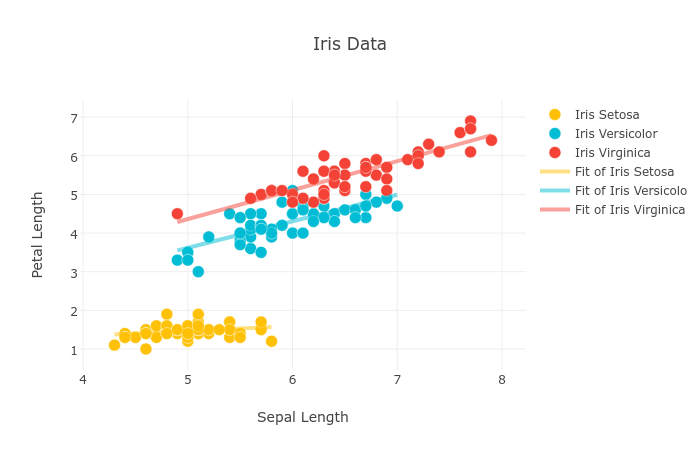JavaScript機(jī)器學(xué)習(xí)之KNN算法

上圖使用 plot.ly 所畫。
上次我們用JavaScript實(shí)現(xiàn)了 線性規(guī)劃 ,這次我們來聊聊KNN算法。
KNN是 k-Nearest-Neighbours 的縮寫,它是一種監(jiān)督學(xué)習(xí)算法。KNN算法可以用來做分類,也可以用來解決回歸問題。
GitHub倉庫: machine-learning-with-js
KNN算法簡介簡單地說, KNN算法由那離自己最近的K個點(diǎn)來投票決定待分類數(shù)據(jù)歸為哪一類 。
如果待分類的數(shù)據(jù)有這些鄰近數(shù)據(jù), NY : 7 , NJ : 0 , IN : 4 ,即它有7個 NY 鄰居,0個 NJ 鄰居,4個 IN 鄰居,則這個數(shù)據(jù)應(yīng)該歸類為 NY 。
假設(shè)你在郵局工作,你的任務(wù)是為郵遞員分配信件,目標(biāo)是最小化到各個社區(qū)的投遞旅程。不妨假設(shè)一共有7個街區(qū)。這就是一個實(shí)際的分類問題。你需要將這些信件分類,決定它屬于哪個社區(qū),比如 上東城 、 曼哈頓下城 等。
最壞的方案是隨意分配信件分配給郵遞員,這樣每個郵遞員會拿到各個社區(qū)的信件。
最佳的方案是根據(jù)信件地址進(jìn)行分類,這樣每個郵遞員只需要負(fù)責(zé)鄰近社區(qū)的信件。
也許你是這樣想的:”將鄰近3個街區(qū)的信件分配給同一個郵遞員”。這時,鄰近街區(qū)的個數(shù)就是 k 。你可以不斷增加 k ,直到獲得最佳的分配方案。這個 k 就是分類問題的最佳值。
KNN代碼實(shí)現(xiàn)像 上次 一樣,我們將使用 mljs 的 KNN 模塊 ml-knn 來實(shí)現(xiàn)。
每一個機(jī)器學(xué)習(xí)算法都需要數(shù)據(jù),這次我將使用 IRIS數(shù)據(jù)集 。其數(shù)據(jù)集包含了150個樣本,都屬于 鳶尾屬 下的三個亞屬,分別是 山鳶尾 、 變色鳶尾 和 維吉尼亞鳶尾 。四個特征被用作樣本的定量分析,它們分別是 花萼 和 花瓣 的長度和寬度。
1. 安裝模塊$npm install ml-knn@2.0.0 csvtojson prompt
ml-knn : k-Nearest-Neighbours 模塊,不同版本的接口可能不同,這篇博客使用了2.0.0
csvtojson : 用于將CSV數(shù)據(jù)轉(zhuǎn)換為JSON
prompt : 在控制臺輸入輸出數(shù)據(jù)
2. 初始化并導(dǎo)入數(shù)據(jù)IRIS數(shù)據(jù)集 由加州大學(xué)歐文分校提供。
curl https://archive.ics.uci.edu/ml/machine-learning-databases/iris/iris.data > iris.csv
假設(shè)你已經(jīng)初始化了一個NPM項(xiàng)目,請在 index.js 中輸入以下內(nèi)容:
const KNN = require(’ml-knn’);const csv = require(’csvtojson’);const prompt = require(’prompt’);var knn;const csvFilePath = ’iris.csv’; // 數(shù)據(jù)集const names = [’sepalLength’, ’sepalWidth’, ’petalLength’, ’petalWidth’, ’type’];let seperationSize; // 分割訓(xùn)練和測試數(shù)據(jù)let data = [], X = [], y = [];let trainingSetX = [], trainingSetY = [], testSetX = [], testSetY = []; seperationSize 用于分割數(shù)據(jù)和測試數(shù)據(jù)
使用csvtojson模塊的fromFile方法加載數(shù)據(jù):
csv( { noheader: true, headers: names }) .fromFile(csvFilePath) .on(’json’, (jsonObj) => { data.push(jsonObj); // 將數(shù)據(jù)集轉(zhuǎn)換為JS對象數(shù)組 }) .on(’done’, (error) => { seperationSize = 0.7 * data.length; data = shuffleArray(data); dressData(); });
我們將 seperationSize 設(shè)為樣本數(shù)目的0.7倍。注意,如果訓(xùn)練數(shù)據(jù)集太小的話,分類效果將變差。
由于數(shù)據(jù)集是根據(jù)種類排序的,所以需要使用 shuffleArray 函數(shù)對數(shù)據(jù)進(jìn)行混淆,這樣才能方便分割出訓(xùn)練數(shù)據(jù)。這個函數(shù)的定義請參考StackOverflow的提問 How to randomize (shuffle) a JavaScript array? :
function shuffleArray(array){ for (var i = array.length - 1; i > 0; i--) { var j = Math.floor(Math.random() * (i + 1)); var temp = array[i]; array[i] = array[j]; array[j] = temp; } return array;} 3. 轉(zhuǎn)換數(shù)據(jù)
數(shù)據(jù)集中每一條數(shù)據(jù)可以轉(zhuǎn)換為一個JS對象:
{sepalLength: ‘5.1’,sepalWidth: ‘3.5’,petalLength: ‘1.4’,petalWidth: ‘0.2’,type: ‘Iris-setosa’ }
在使用 KNN 算法訓(xùn)練數(shù)據(jù)之前,需要對數(shù)據(jù)進(jìn)行這些處理:
將屬性(sepalLength, sepalWidth,petalLength,petalWidth)由字符串轉(zhuǎn)換為浮點(diǎn)數(shù). ( parseFloat ) 將分類 (type)用數(shù)字表示function dressData(){ let types = new Set(); data.forEach((row) => { types.add(row.type); }); let typesArray = [...types]; data.forEach((row) => { let rowArray, typeNumber; rowArray = Object.keys(row).map(key => parseFloat(row[key])).slice(0, 4); typeNumber = typesArray.indexOf(row.type); // Convert type(String) to type(Number) X.push(rowArray); y.push(typeNumber); }); trainingSetX = X.slice(0, seperationSize); trainingSetY = y.slice(0, seperationSize); testSetX = X.slice(seperationSize); testSetY = y.slice(seperationSize); train();} 4. 訓(xùn)練數(shù)據(jù)并測試
function train(){ knn = new KNN(trainingSetX, trainingSetY, { k: 7 }); test();}
train方法需要2個必須的參數(shù): 輸入數(shù)據(jù),即 花萼 和 花瓣 的長度和寬度;實(shí)際分類,即 山鳶尾 、 變色鳶尾 和 維吉尼亞鳶尾 。另外,第三個參數(shù)是可選的,用于提供調(diào)整 KNN 算法的內(nèi)部參數(shù)。我將 k 參數(shù)設(shè)為7,其默認(rèn)值為5。
訓(xùn)練好模型之后,就可以使用測試數(shù)據(jù)來檢查準(zhǔn)確性了。我們主要對預(yù)測出錯的個數(shù)比較感興趣。
function test(){ const result = knn.predict(testSetX); const testSetLength = testSetX.length; const predictionError = error(result, testSetY); console.log(`Test Set Size = ${testSetLength} and number of Misclassifications = ${predictionError}`); predict();}
比較預(yù)測值與真實(shí)值,就可以得到出錯個數(shù):
function error(predicted, expected){ let misclassifications = 0; for (var index = 0; index < predicted.length; index++) { if (predicted[index] !== expected[index]) { misclassifications++; } } return misclassifications;} 5. 進(jìn)行預(yù)測(可選)
任意輸入屬性值,就可以得到預(yù)測值
function predict(){ let temp = []; prompt.start(); prompt.get([’Sepal Length’, ’Sepal Width’, ’Petal Length’, ’Petal Width’], function(err, result) { if (!err) { for (var key in result) { temp.push(parseFloat(result[key])); } console.log(`With ${temp} -- type = ${knn.predict(temp)}`); } });} 6. 完整程序
完整的程序 index.js 是這樣的:
const KNN = require(’ml-knn’);const csv = require(’csvtojson’);const prompt = require(’prompt’);var knn;const csvFilePath = ’iris.csv’; // 數(shù)據(jù)集const names = [’sepalLength’, ’sepalWidth’, ’petalLength’, ’petalWidth’, ’type’];let seperationSize; // 分割訓(xùn)練和測試數(shù)據(jù)let data = [], X = [], y = [];let trainingSetX = [], trainingSetY = [], testSetX = [], testSetY = [];csv( { noheader: true, headers: names }) .fromFile(csvFilePath) .on(’json’, (jsonObj) => { data.push(jsonObj); // 將數(shù)據(jù)集轉(zhuǎn)換為JS對象數(shù)組 }) .on(’done’, (error) => { seperationSize = 0.7 * data.length; data = shuffleArray(data); dressData(); });function dressData(){ let types = new Set(); data.forEach((row) => { types.add(row.type); }); let typesArray = [...types]; data.forEach((row) => { let rowArray, typeNumber; rowArray = Object.keys(row).map(key => parseFloat(row[key])).slice(0, 4); typeNumber = typesArray.indexOf(row.type); // Convert type(String) to type(Number) X.push(rowArray); y.push(typeNumber); }); trainingSetX = X.slice(0, seperationSize); trainingSetY = y.slice(0, seperationSize); testSetX = X.slice(seperationSize); testSetY = y.slice(seperationSize); train();}// 使用KNN算法訓(xùn)練數(shù)據(jù)function train(){ knn = new KNN(trainingSetX, trainingSetY, { k: 7 }); test();}// 測試訓(xùn)練的模型function test(){ const result = knn.predict(testSetX); const testSetLength = testSetX.length; const predictionError = error(result, testSetY); console.log(`Test Set Size = ${testSetLength} and number of Misclassifications = ${predictionError}`); predict();}// 計算出錯個數(shù)function error(predicted, expected){ let misclassifications = 0; for (var index = 0; index < predicted.length; index++) { if (predicted[index] !== expected[index]) { misclassifications++; } } return misclassifications;}// 根據(jù)輸入預(yù)測結(jié)果function predict(){ let temp = []; prompt.start(); prompt.get([’Sepal Length’, ’Sepal Width’, ’Petal Length’, ’Petal Width’], function(err, result) { if (!err) { for (var key in result) { temp.push(parseFloat(result[key])); } console.log(`With ${temp} -- type = ${knn.predict(temp)}`); } });}// 混淆數(shù)據(jù)集的順序function shuffleArray(array){ for (var i = array.length - 1; i > 0; i--) { var j = Math.floor(Math.random() * (i + 1)); var temp = array[i]; array[i] = array[j]; array[j] = temp; } return array;}
在控制臺執(zhí)行 node index.js
$ node index.js
輸出如下:
Test Set Size = 45 and number of Misclassifications = 2prompt: Sepal Length: 1.7prompt: Sepal Width: 2.5prompt: Petal Length: 0.5prompt: Petal Width: 3.4With 1.7,2.5,0.5,3.4 -- type = 2 參考鏈接 K NEAREST NEIGHBOR 算法 安德森鳶尾花卉數(shù)據(jù)集
歡迎加入 我們Fundebug 的 全棧BUG監(jiān)控交流群: 622902485 。

來自:https://kiwenlau.com/2017/07/10/javascript-machine-learning-knn/
相關(guān)文章:
1. php網(wǎng)絡(luò)安全中命令執(zhí)行漏洞的產(chǎn)生及本質(zhì)探究2. 三個不常見的 HTML5 實(shí)用新特性簡介3. Angular獲取ngIf渲染的Dom元素示例4. IIS+PHP添加對webp格式圖像的支持配置方法5. ASP調(diào)用WebService轉(zhuǎn)化成JSON數(shù)據(jù),附j(luò)son.min.asp6. 無線標(biāo)記語言(WML)基礎(chǔ)之WMLScript 基礎(chǔ)第1/2頁7. 使用.net core 自帶DI框架實(shí)現(xiàn)延遲加載功能8. Warning: require(): open_basedir restriction in effect,目錄配置open_basedir報錯問題分析9. php測試程序運(yùn)行速度和頁面執(zhí)行速度的代碼10. ASP.NET Core 5.0中的Host.CreateDefaultBuilder執(zhí)行過程解析

 網(wǎng)公網(wǎng)安備
網(wǎng)公網(wǎng)安備